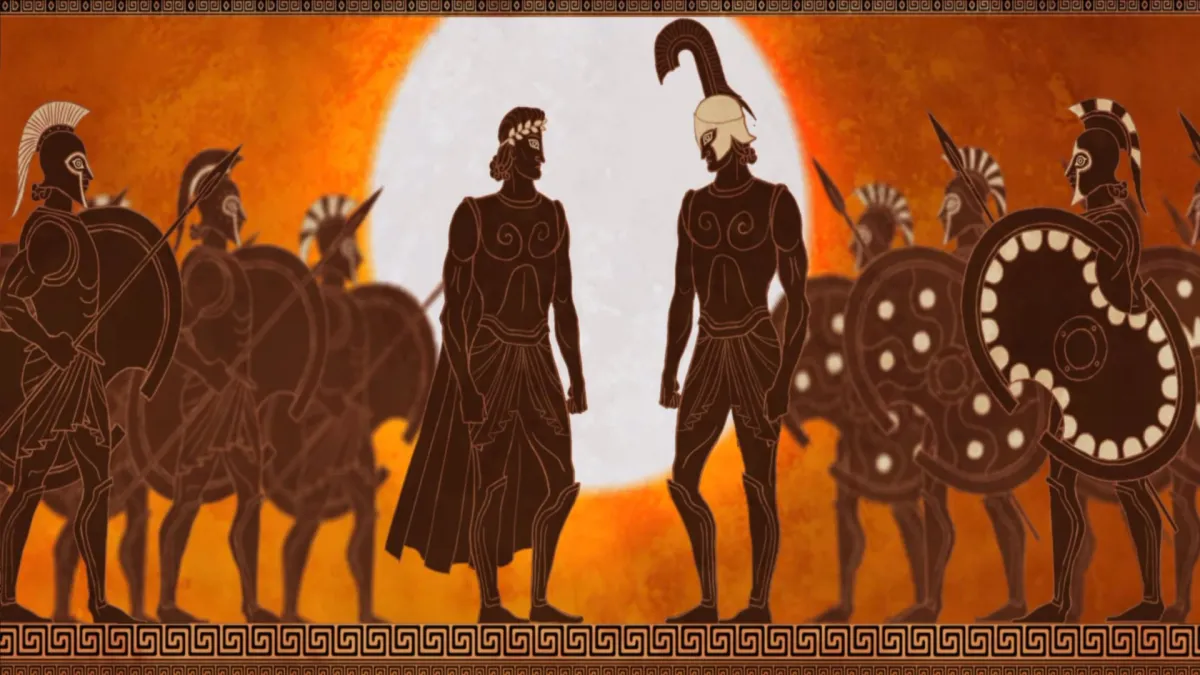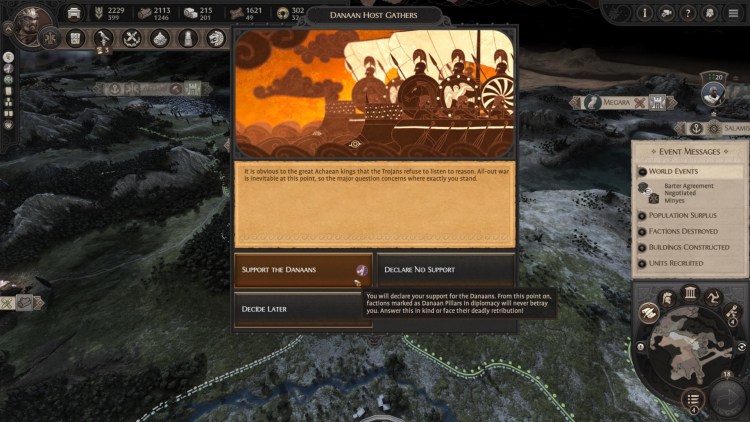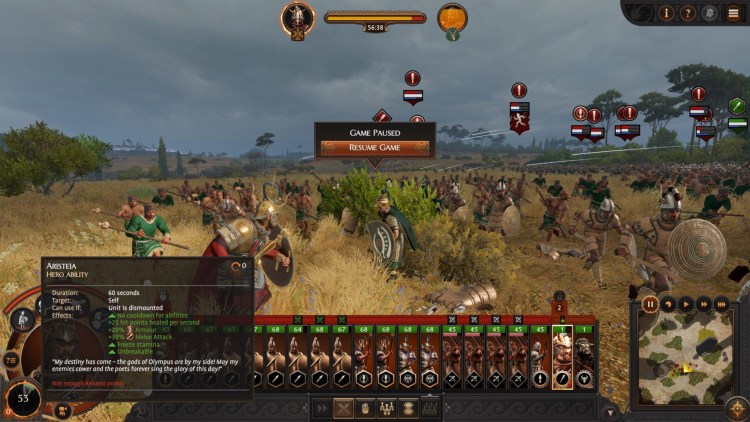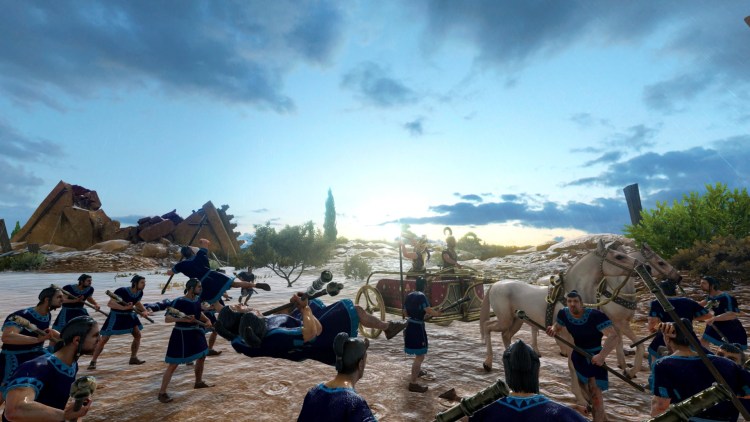Total War Saga: Troy presents you with concepts and ideas to freshen up your playthroughs. Some might feel familiar. Others, meanwhile, will be completely new. Here’s our Total War Saga: Troy beginner’s guide to help you out. Oh, and don’t forget that the game also has its own “tutorial mode” for newcomers.
Note: For more information, check out our Total War Saga: Troy guides and features hub.
Total War Saga: Troy Beginner’s guide
Victory conditions
There are two victory types in Total War Saga: Troy‘s campaign. First, there’s the Total War Victory which is the same for all factions:
- Defeat your first “antagonist” (more on this mechanic later).
- Capture, sack, or raze 100 settlements.
- Control specific provinces directly or through vassals and military allies (defensive alliances don’t count).
Next, there’s the Homeric Victory:
- Complete all “epic missions” for your faction leader (more on this mechanic later).
- Defeat specific factions from the opposing side (i.e., Greeks vs. Trojans).
- Some faction leaders may have an additional requirement. For instance, Agamemnon needs to have 60% or more influence in certain provinces. Achilles, meanwhile, has to reach the level 27 cap.
You can see an example below showing Hector’s Homeric Victory requirements:
The antagonist mechanic
This feature in Total War Saga: Troy is somewhat akin to Realm Divide (Shogun 2), Civil War (Rome 2), or Emperor Declaration (Three Kingdoms). No, the entire world won’t suddenly fracture. Instead, the game will select a faction that’ll become your antagonist. The selection comes from a variety of factors such as betraying a leader, warring with them often, committing atrocities, and the like.
As mentioned, defeating your first antagonist is one of the requirements for the Total War victory. However, if it happens to be a faction that you need to eliminate (for the Homeric Victory), the campaign can turn into a slog or a whack-a-mole session.
For example, in the same campaign as Hector, Odysseus/Ithaca also became my first antagonist faction. I went well over the 100 settlement tally because — against all logic, reason, and normalcy — it took a while before Sean Bean’s character died.
Anyway, once you have an antagonist, you’ll see additional background information via a new panel on the campaign map. Diplomacy will also be disabled for that faction and it’ll become a battle to the death. There’s also a “scorched earth” policy that can be active whereby conquering your antagonist’s settlements will show you that only the main building is left standing — every other structure has been destroyed and you’d need to restore them from scratch. Conversely, your antagonist might change its strategy and opt to sack all your undefended settlements rather than capturing or razing them.
Epic missions
Think of these as quest chains for your chosen faction leader. Some would present you with dilemmas while others would have a specific objective that needs to be met—ie, reach 60% influence in a province or have an alliance with a certain lord.
As mentioned in our official review, this concept definitely confused me at first. That’s because the triggers for most quest steps remain a mystery to me. I’m not sure if they’re dependent on the number of turns in your campaign, or due to some other factor entirely. Sometimes, I found myself with a new epic mission after completing the previous one. In other instances, I had to wait for five, 10, or over a dozen turns before I saw the next task.
Bartering and resources
In previous Total War games, you often just took note of gold. In Total War Saga: Troy, however, you’ll need to manage five resource types:
- Food – unit recruitment, basic military buildings, and prayers/Hecatombs
- Wood – building construction and chariot recruitment
- Stone – building construction (advanced types)
- Bronze – unit recruitment (advanced types such as heavily armored troops)
- Gold – prayers, rededicating temples, and certain units
These resources can also be used for other functions such as the tech tree (called “Royal Decrees” in Total War Saga: Troy) or during certain dilemmas/events.
Likewise, you’ll see icons of each resource on the nameplates of minor settlements. These show you the resources that are being produced in that settlement just in case you want to construct the “farm-type” buildings to boost production.
Much like Total War: Three Kingdoms, Troy also uses a barter system letting you exchange multiple types of resources (either a specific amount in one go or per turn). You’ll use these resources as leverage for diplomatic deals (ie, non-aggression pacts, alliances, peace deals, vassalization, and even obtaining adjacent settlements). It’s possible to have multiple barter deals exchanging the same resource too.
There is, however, something odd that I encountered while reviewing the game. There’s actually a bug related to the barter/resource system that can be exploited. Oh, and my guess is that the AI uses it too because of how quickly some leaders amass riches.
Hero classes
Faction leaders/generals/legendary lords—at least in Total War Saga: Troy—are known as heroes. Meanwhile, playable leaders such as Achilles and Hector are called “epic heroes.” I don’t think that has anything to do with the Epic Games timed exclusivity. Anyway, heroes come in different classes and they even have their own “subclasses” to boot:
- Warlords – All-rounders who tend to have a lot of campaign/faction-wide buffs. The “Commander” subclass, in particular, can get the “Inspirational Leader” perks at level 5, giving additional unit recruitment slots.
- Fighters – These are melee combatants who like to get into the thick of the fray. They have several perks to boost armor-piercing damage and rage generation.
- Defenders – These types of heroes like to taunt opponents to aggro them (while troops smack them around). They also have a few support abilities to buff their armor, stamina, or HP.
- Archers – Archer heroes primarily snipe targets from afar or rain down a barrage of arrows. But, they can also turn into hybrid melee fighters when needed.
Note 1: Each faction in Total War Saga: Troy will have a specific hero class that can’t be recruited. For instance, Hector can’t recruit Archer heroes (unless you confederate factions that have one already).
Note 2: Generic heroes also follow the “motivation” system. Motivation fluctuates depending on a hero’s preferences—ie, they like/dislike a god, they like/dislike to raid or sack settlements, they like/dislike fighting battles with reinforcements. Higher motivation allows heroes to perform better, but lower values lead to poorer output. Still, no matter how low motivation gets, they won’t become disloyal.
Leveling up your generals and agents
The image above shows the Warlord – Commander’s “Inspirational Leader” perk at level 5. You probably noticed that there are two main selections for each level (some have smaller nodes too). Well, in Total War Saga: Troy, picking a perk or skill for that level automatically locks out its counterpart. If there are two extra nodes (providing additional boons), then you can choose only one as well. As such, it’s important to take note of a “build” that you’d like to end up with. Oh, and this system also comes into play for your regular agents like the spy, priestess, and envoy.
The skill lines/mutually exclusive choices only go up to level 14. But, you do gain XP until level 27 (the cap). You can also store skill points and ignore some level-up perks that you don’t want. This way, you can stack specific buffs for later.
The same leveling system and concepts also apply to your agents. For example, I like stacking boosts to critical success rate, happiness, and divine favor gains for my priestesses. These let me “farm” temples to help with the Divine Will mechanic.
Note: Regarding agents, your entire faction is limited to three of each type (envoys, priestesses, and spies). However, some factions such as Prince Hector of Troy have the means to get past this limit.
Divine Will – The gods and goddesses
Speaking of Divine Will, this is how gods and goddesses come into play in Total War Saga: Troy. It’s a bit like a “button-click” mechanic, though there are more strategizing opportunities and synergies involved. That’s because this is also tied to:
- the temples/shrines you’ve built
- reaching a certain tier level for that god’s cult of worshipers
- praying to a god to get a blessing for several turns
- passive and active buffs during battles or while exploring the campaign map
- using a priestess or a seer to gain favor
- initiating a hecatomb (sacrifice) to gain a huge amount of favor
For instance, I usually pop a hecatomb and a prayer to Athena during the first turn. This will boost her cult to the next tier and, on my next turn, I’ll get additional recruitment slots and higher-ranked troops.
Note 1: You can learn more about this mechanic in our Divine Will/gods and goddesses guide.
Note 2: Reaching the maximum tier for a cult unlocks mythological creatures for recruitment. You can check our mythological creatures and epic agents guide for more info.
The Gathering Host event
There’s also one important event/dilemma to take note of during your Total War Saga: Troy campaign and that’s the “Gathering Host.” You may declare your support for the Danaans/Greeks or Trojans depending on your chosen lord, waive your support, or decide later.
If you choose to support your faction, those who are considered as “pillars” of that faction won’t betray you for the rest of the campaign. However, there’s a chance that you might end up being embroiled in wars with the other Greek minor lords due to an intricate web of alliances.
Rage and Aristeia
Rage is a resource that your characters accumulate during battles. Your heroes need to continuously fight hostile troops to generate rage and, in turn, this is spent on various abilities. It’s a bit like playing a warrior in World of Warcraft. Certain level-up perks also allow you to generate rage even when you’re out of combat, so make sure to pick these up.
As for Aristeia, it comes from the Greek word “aristos” (meaning “best”) and, as such, it signifies a defining moment in a hero’s journey. Examples can be found in The Iliad where Greek and Trojan champions took out countless foes, laid waste to their enemies, and, essentially had their “finest hour.”
In Total War Saga: Troy, Aristeia acts like a “super” of sorts that can be used once per battle. You can see the effects of Agamemnon’s Aristeia in the image above.
The goal is to build up rage, then use rage to cast skills and get your Aristeia ready. Once the battle has reached a fever pitch or you’re in a bind, activate it so you can clean house.
Chariots and cycle-charging
Total War veterans should be very familiar with the concept of cycle-charging your cavalry units. Well, how exactly do you do that without cavalry units in Total War Saga: Troy? The answer is “chariots.”
The regular chariot units you obtain are vulnerable and very costly, but they can cause quite a ruckus when they automatically charge back and forth enemy unit formations. It’s not as precise (or as brutal) a perfectly timed cycle-charge, but it does work as long as you don’t get bogged down by massed enemy troops.
Even better, try to look for heroes and epic heroes that can obtain the melee chariot and its reinforced melee chariot upgrade (i.e., Achilles). Having a chariot mount prevents leaders from losing stamina since they’re no longer running around the battlefield. Combined with other leveling perks such as melee attack, armor, and limited HP regen, your generals will be next to unstoppable. The main drawback is that you can’t use most of your abilities or Aristeia while mounted and, if you dismount, you can’t get back on your chariot again.
Still, chariots are an awesome way to run roughshod over most enemy armies. Total War Saga: Troy‘s battle AI (even on veteran/very hard difficulty) would even make archers and slingers avoid wasting arrows on a lonely general (whether mounted or dismounted). You should be able to rip apart hundreds of troops before you call for backup.
A cheesy siege
We’ll need to talk about sieges too. After all, Total War Saga: Troy is based on the legendary siege from a mythical time. However, the siege options in the game are quite paltry — you only have rams, ladders, and, eventually, the siege towers known as “Trojan Horses” to help you crush a defender’s forces.
The good news is that you can somewhat cheese siege battles by opening the gate early. How do you do this? Well, certain settlements have gate towers that have a blind spot… right in front of the gate. That means you can use a hero to beeline for the gate and have them kick and slash it until it cracks open.
Below, you’ll see Achilles practically kicking down the town’s gate since he probably considers every day as leg day. Good thing he didn’t injure his heel in the process.
The city of Troy
As for Troy itself, capturing this city is a key objective for the Greek leaders. However, because it’s the actual “great siege of legends,” you’re not allowed to auto-resolve this fight. You’re going to have to win the siege manually (I’ll talk more about battles and sieges later). Don’t forget that Troy will replenish casualties at a ridiculously fast rate, and your agents won’t even be able to sabotage the settlement.
Additionally, Troy’s main building, as well as other structures in the settlement, can be damaged severely by a wrathful Poseidon. This occurs from time to time during the campaign. In fact, the main settlement building can’t be repaired manually. If you’re controlling the city, you need to wait for several turns until you get a notification that says “Troy has recovered.” Unfortunately, I haven’t tried timing this with a maxed out Cult of Poseidon to see if this would somehow speed up the process or prevent the god from destroying the city.
If you are playing as one of the Greek factions, though, then this will be an opportune time to strike. The devastating earthquake from Poseidon will tear down Troy’s walls and severely damage its garrison. The once-vaunted defenses now look like a desolate wasteland.
Total War Saga: Troy is available via the Epic Games Store. For more information, check out our guides and features hub.





















Published: Aug 13, 2020 07:00 am